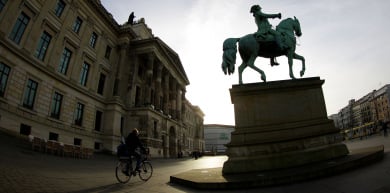Planning is underway to rebuild long-destroyed palaces in Berlin, Hanover and Potsdam; a former royal hunting lodge in the west could also rise again soon; a palace in Dresden is nearing completion and last year, the exterior of a Braunschweig palace was completed.
After World War II, many German cities rebuilt damaged and destroyed palaces and historic buildings. But urban planners in both East and West Germany also demolished many ruined buildings on ideological and aesthetic grounds.
This latest wave of reconstruction stems directly from the demise of former communist East Germany in 1990 and the successful reconstruction of Dresden, according to Gabi Dolf-Bonekaemper, a professor at Berlin’s Technical University.
“The idea is that it is feasible, that it can be done, that money can found, and what comes out of it is not ugly, and it’s not a fake, it’s something different,” Dolf-Bonekaemper said.
Others connect the campaign to rebuild long-destroyed palaces to a cultural identity crisis afflicting Germany and a rebellion against high-concept modern architecture.
“It’s linked to anxiety about globalization,” Peter Schabe of the German Foundation for Historic Preservation told AFP, “People want a place to identify with, and they want to create cities that looked like they did long ago.”
The 18th century palace in Braunschweig was heavily damaged in World War II and demolished in 1960. Last year, it was resurrected as a €200 million ($310 million) shopping centre by property developers ECE. Visitors who enter the palace might expect to see an elaborate ceremonial hallway or other signs of the building’s noble past. Instead, immediately inside sits a Starbucks coffee shop. The centre’s interior is completely modern in stark contrast to the historic facade.
But the fusion of modern commerce with royal pomp has been a success, with more than nine million visitors in the mall’s first year, centre manager Jan Tangerding said.
“Of course there are critical voices who say, ‘look, there’s a big block stuck behind [the facade] that’s a shopping centre,’ but they’re relatively few and getting quieter,” Tangerding said.
The question of how to use a rebuilt palace hangs over every project.
Hanover’s Herrenhausen Palace will serve as a “future-oriented convention centre” for the Volkswagen Foundation, which announced plans last year to rebuild the palace’s facade to how it was before being destroyed in 1943.
In Potsdam, the capital of the state of Brandenburg, real estate developers approached the city and offered to rebuild the destroyed City Palace, one of many belonging to the Prussian royal family, as a shopping mall.
The city rejected that offer, and philanthropist Hasso Plattner, a co-founder of the software firm, SAP, donated €20 million to rebuild the palace’s facade. Last month, the Brandenburg state legislature approved the design and voted to move into the as-yet unbuilt palace by 2012.
Preservationists warn that building replicas of palaces can be misleading for those with no memory of the original building.
“Citizens see these [new] buildings as something that has been historically preserved, but they’re not, they are new buildings,” Schabe of the German Foundation for Historical Preservation said.
“When young people embrace a place that they’ve never seen before, that they don’t know, then history has been ‘adjusted’ somewhat,” Schabe said. “And for preservationists that’s a big problem.”
The debate over whether to rebuild Berlin’s City Palace has raged since German reunification in 1990.
The original palace was heavily damaged during World War II. After the war, East German authorities demolished what was left and built their own modern palace – the Palace of the Republic. That building also housed the East German parliament, several restaurants and a disco. After reunification, Berlin authorities soon had the Communist-era building condemned on the grounds of asbestos contamination.
The Palace of the Republic is currently being torn down, and construction of a replica of the City Palace, which may house a cultural forum affiliated with nearby Humboldt University, is due to begin in 2010.
Spiralling cost estimates for the new palace have slowed the project, but the federal government has promised to pay a major portion of the costs, currently approaching nearly €500 million.
The Technical University’s Dolf-Bonekaemper warns that the desire to rebuild buildings destroyed over 60 years ago may make it harder to preserve scores of smaller, authentic historic buildings outside of major cities.
“We see the money going elsewhere, and it’s sometimes impossible to attract investors to real monuments,” she said. “Germany is full of castles that are sold for one euro because no one would want to invest one cent into them because they are badly situated.”


 Please whitelist us to continue reading.
Please whitelist us to continue reading.